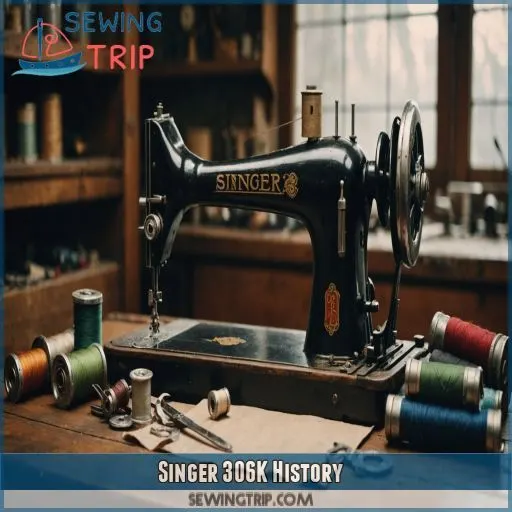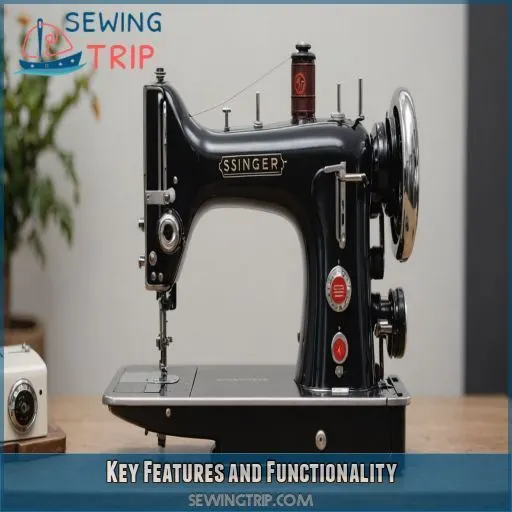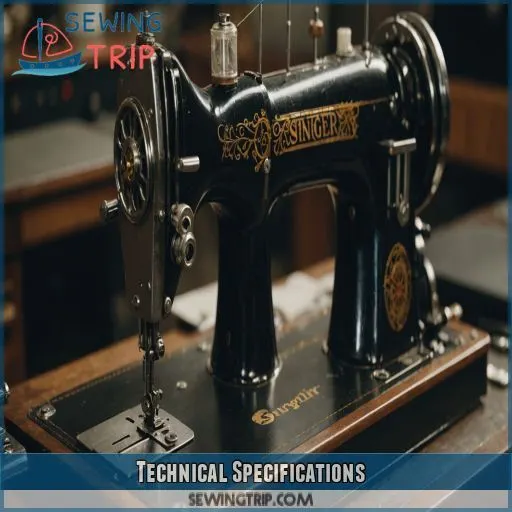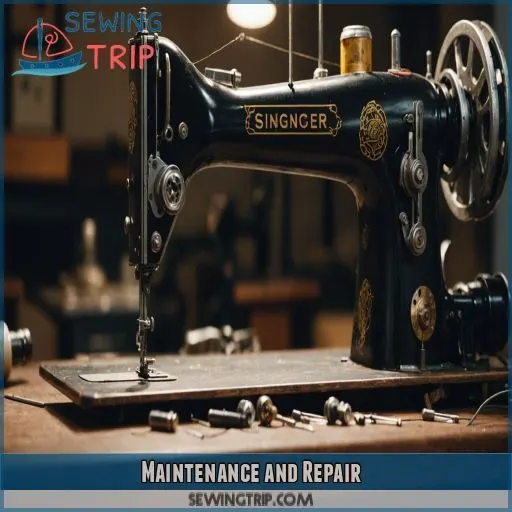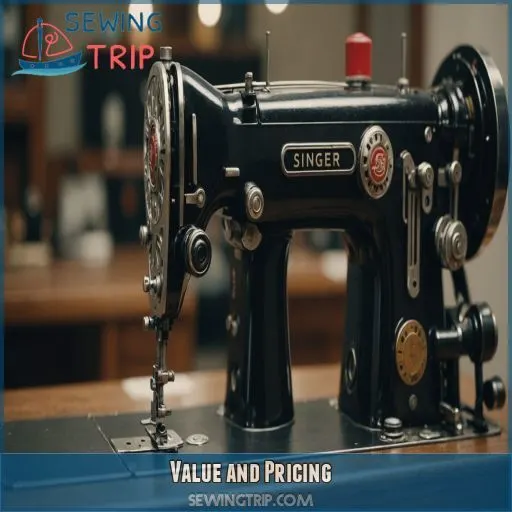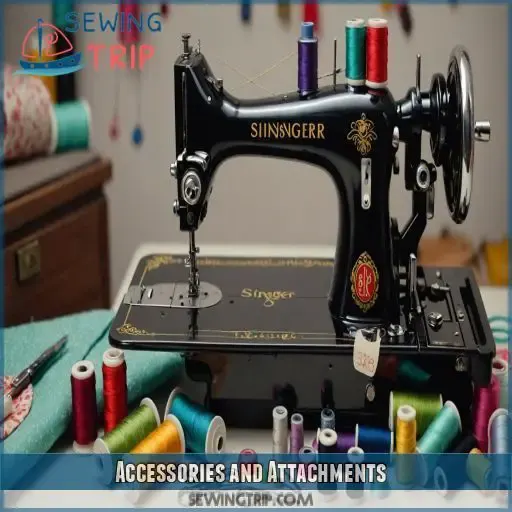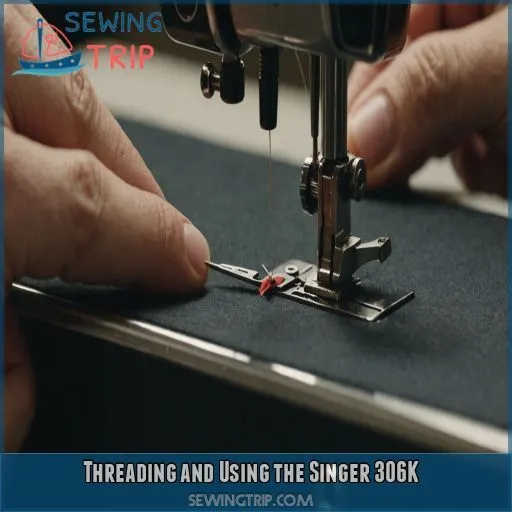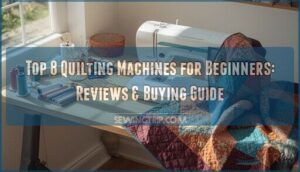This site is supported by our readers. We may earn a commission, at no cost to you, if you purchase through links.
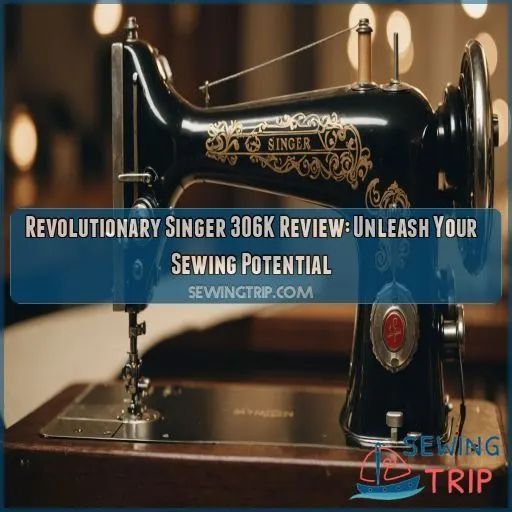
This vintage gem, produced from 1954 to 1961, packs a punch with its sturdy cast aluminum body and built-in zigzag stitch.
It’s like the Swiss Army knife of sewing machines – versatile and reliable.
You’ll love the twin needle capability and reverse feed, perfect for creating intricate designs.
Sure, it might be older than your favorite vinyl records, but don’t let that fool you.
With proper care, this workhorse can still outperform some modern machines.
Whether you’re a seasoned seamstress or a curious collector, the Singer 306K offers a unique blend of nostalgia and functionality.
Ready to stitch through time?
Table Of Contents
Key Takeaways
- You’re looking at a true vintage gem with the Singer 306K, produced from 1954 to 1961. It’s like the Swiss Army knife of sewing machines – versatile, reliable, and packed with features that’ll make your stitches shine.
- Don’t let its age fool you – this workhorse can still outperform some modern machines. With its sturdy cast aluminum body, built-in zigzag stitch, and twin-needle capability, you’ll be tackling everything from delicate embroidery to heavy-duty denim with ease.
- You’ll love the 306K’s full reverse feed and free-motion embroidery capabilities. It’s like having a time machine that lets you create intricate designs with vintage flair. Just remember to use the correct 206×13 needles – your machine will thank you!
- Whether you’re a seasoned seamstress or a curious collector, the Singer 306K offers a unique blend of nostalgia and functionality. It’s like adopting a piece of sewing history that’s still ready to work. With proper care and maintenance, you’ll be stitching through time for years to come.
Singer 306K History
You’re about to meet the Singer 306K, a sewing machine that’s been making waves since its production from 1954 to 1962. As an upgrade to the Singer 206, the 306K boasts exciting features and improvements that’ll make you wonder how you ever sewed without it.
Production Years
Hey there, sewing enthusiast! Are you curious about the Singer 306K‘s production years? This vintage sewing machine was manufactured from 1954 to 1961 at the Kilbowie factory (Source). To pinpoint the exact production date, check the serial number using the ISMACS serial number database (Source). Now, get ready to put your sewing skills to the test with this iconic machine!
Upgrades From Previous Models
You’re stepping up your sewing game with the Singer 306K! As an upgrade from the 206, this machine boasts a zigzag stitch, Twin Needle capability, and reverse feed. You’ll love the freedom to create decorative stitching and enjoy free motion embroidery. Here are three key upgrades that’ll get you excited:
- Zigzag stitch: Add some flair to your sewing projects with this versatile stitch.
- Twin needle capability: Double the fun with twin needles for decorative stitching and more.
- Reverse feed: Say goodbye to tedious backstitching with the 306K’s convenient reverse feed feature.
Assembly Locations and Letter Designations
You’re probably curious about where your Singer 306K was born. The letter designation on your machine indicates its assembly location: W for Connecticut, K for the UK, and M for Italy. Knowing this helps you identify your machine’s country of origin and production date. This info is important in figuring out your vintage sewing machine’s value and history.
Key Features and Functionality
You’re about to discover the amazing capabilities of the Singer 306K, a machine that’s packed with innovative features to take your sewing to the next level. From its sturdy cast aluminum body and built-in zigzag capability to its twin spool pins and tension discs, this machine is designed to make your sewing experience smoother and more enjoyable .
Cast Aluminum Body and Zigzag Capability
The Singer 306K boasts a robust cast aluminum body, perfect for withstanding heavy use. Its zigzag capability opens up a world of creative stitching possibilities. You’ll love the machine’s full-size design, which provides ample space for large projects. The durable cast aluminum construction helps keep the machine cool, reducing the risk of overheating and extending the machine’s lifespan.
- Feel the weight and solidity of the machine, giving you confidence in its durability
- Marvel at the clever design evolution that led to the 306K’s sleek and functional style
- Appreciate the thoughtful material choice, combining strength and style
- Enjoy the tactile experience of the Bakelite foot pedal, responding effortlessly to your touch
Twin Spool Pins and Tension Discs
Now that we’ve explored the cast aluminum body and zigzag capability, let’s talk twin spool pins and tension discs. These features allow for twin needle sewing, perfect for decorative stitches. To get the best results, adjust the tension discs according to your fabric type and thread choice. Remember to use special needles, like the 206×13, for smooth sewing.
Full Reverse Feed and Free Motion Embroidery
You’re about to unleash the Singer 306K’s full potential! Mastering full reverse feed and free motion embroidery will take your sewing skills to new heights. Here are three expert tips to get you started:
- Reverse feed techniques: Utilize the 306K’s full reverse feed to create intricate designs and patterns with ease.
- Free motion tips: Adjust your needle thread tension for smooth, even stitches when using free motion mode.
- Embroidery stitches: Experiment with different decorative stitching techniques using the 206×13 needles, ideal for vintage sewing machines.
Automatic Stitch Patterns and Pattern Cams
Now that you’ve mastered full reverse feed and free motion embroidery, let’s explore the Singer 306K’s automatic stitch patterns and pattern cams. Earlier models used plastic pattern discs for varied stitch designs, while later ones didn’t. Be aware that using incorrect or damaged cams can lead to zigzag stitch issues. Experiment with different cam designs for unique stitch pattern variations.
Technical Specifications
You’re about to get up close and personal with the Singer 306K’s technical specs, which are pretty cool. In this section, we’ll break down the nitty-gritty details, from the base size and motor type to the drive belt, speed control, needle type, and bobbin case, so you can understand what makes this sewing machine tick.
Base Size and Motor Type
If you’re looking at the Singer 306K, you’ll want to know how the base size and motor type affect your sewing experience. The base size is a generous 14-3/4", giving you ample space to work on your projects. As for the motor, the Singer BAK (external with V belt) provides reliable power.
- The base size accommodates larger projects, like quilts or curtains.
- The BAK motor is designed for heavy-duty use, so you can sew with confidence.
- If you need to replace the motor, you can find compatible options, like the 0.9 amp, 7000 rpm motor .
Drive Belt and Speed Control
Get a grip on your Singer 306K’s speed!
The drive belt, part number 189651, measures 38.5cm in outer diameter.
Make sure it’s the right fit when you replace it.
The Bakelite foot pedal (Style B) controls speed, but can be finicky.
If your pedal’s stuck, try adjusting it.
Proper speed control is key to smooth sewing – don’t let it get the best of you!
Needle Type and Bobbin Case
Time to get up close and personal with your Singer 306K’s needle and bobbin case. This machine requires special type 206×13 needles with shorter points, so don’t even think about using others – trust us, you don’t want the damage. The removable bobbin case accepts standard bobbins, but make sure to wind them correctly to avoid tension issues.
Special Type 55623 Large Capacity Bobbins
Get the most out of your Singer 306K with special type 55623 large capacity bobbins! These babies can hold more thread, saving you time and hassle. Make sure to wind them correctly to avoid tangles and knots. Also, keep your bobbin case clean and well-maintained to make sure your stitches are smooth. Happy sewing!
Maintenance and Repair
Your Singer 306K is a pretty straightforward machine to work with when it comes to maintenance and repair, but it does require some TLC to keep it running smoothly.
By knowing how to troubleshoot common issues, you’ll be well on your way to becoming a Singer 306K whisperer.
You’ll also need to know how to use the correct needles, adjust the tension assembly, and repair the bobbin case.
Common Issues and Troubleshooting
As you get cozy with your Singer 306K, you might encounter some pesky issues. Don’t worry, we’ll help you sort them out! Common culprits include needle problems, bobbin troubles, and feed dog issues. Tension adjustments can also be a challenge. And, of course, there’s the occasional motor problem. Let’s troubleshoot together and get your machine humming in no time!
Importance of Using Correct Needles
Now that you’ve tackled common issues, let’s talk needles. Using the right ones is really important – it’s not just a suggestion, it’s a lifeline for your 306K. Here’s why:
- Wrong needles can turn your beloved machine into a paperweight
- Correct needles make sure you can sew through various fabrics smoothly
- They’re the unsung heroes of perfect stitches
Don’t be the person who learns this the hard way. Your 306K deserves the royal treatment!
Adjusting Tension Assembly
Got tension troubles? Don’t sweat it! Your Singer 306K’s tension assembly is like a tightrope walker – it needs perfect balance.
First, check your thread and needle type.
If they’re spot-on but your stitches are still wonky, it’s time to tweak that tension.
With a steady hand and a bit of patience, you’ll have your 306K purring like a kitten in no time!
Repairing the Bobbin Case
Is your Singer 306K’s bobbin case giving you a headache? Don’t throw in the towel just yet! With a little elbow grease, you can fix common issues and get back to stitching in no time. Here’s your game plan:
- Check for needle damage
- Remove stubborn bobbins carefully
- Sand away burrs gently
- Adjust tension with expert guidance
Value and Pricing
You’re probably wondering how much your Singer 306K is worth, aren’t you? Well, buckle up because we’re about to take a stroll through the fascinating world of vintage sewing machine pricing, where condition is king and market demand calls the shots.
Factors Affecting Value
Figuring out the price of your Singer 306K is like finding a treasure.
It’s not a simple set price, though.
Think of it like appraising a classic car – factors like how rare it is and how much people want it can make it worth a lot of money.
Accessories can be the icing on the cake, potentially making it even more valuable.
Determining Condition and Completeness
When sizing up a Singer 306K, you’re playing detective.
Start with the obvious: any missing parts?
Check for cosmetic flaws like scratches or dings – they’re like battle scars telling the machine’s story.
Next, put on your mechanic’s hat and assess its working condition.
Are all the gears turning smoothly?
Don’t forget to take stock of accessories included – they’re the supporting cast in your sewing adventures.
Market Demand and Comparison to Other Models
Now that you’ve got a handle on condition, let’s talk shop about the Singer 306K’s market value.
It’s like a vintage car – prices can be all over the map!
Collectors might pay top dollar, while budget-conscious sewers can snag a bargain.
Compared to its siblings, the 319 and 320, the 306K holds its own.
But remember, it’s not just about the price tag – it’s about finding your perfect sewing companion.
Accessories and Attachments
You’ll be amazed at how the right accessories can transform your Singer 306K into a versatile powerhouse. Let’s explore the attachments that’ll help you tackle any sewing project with ease, from using a treadle to comparing it with other Singer models.
Singer 306K Attachments and Accessories
Now that you’ve got your Singer 306K priced and ready, let’s talk accessories!
This sewing powerhouse comes with a treasure trove of attachments.
You’ll find common goodies like buttonhole makers and zipper feet, but also some vintage gems unique to the 306K.
Can’t find what you need? Don’t sweat it!
Many attachments from other Singer models are compatible, opening up a world of creative possibilities.
Using the Singer 306K With a Treadle
Want to give your Singer 306K a vintage makeover?
You’re in luck! This versatile machine can be used with a treadle, letting you sew the old-fashioned way.
Just remove the external motor and swap out the belt.
It’s like stepping back in time while still enjoying modern stitching capabilities.
Setting up your treadle is a breeze, and you’ll be pedaling your way to beautiful creations in no time.
Comparison to Other Singer Models
When comparing the Singer 306K to other models, you’ll find some key differences. The Singer 319 offers built-in stitches selected with typewriter keys, while the 320 is a free-arm version of the 319. Here’s a quick rundown:
- 306K: Versatile workhorse with zigzag capability
- 319: Built-in stitches for easy pattern selection
- 320: Free-arm design for tubular sewing projects
Each model has its strengths, but the 306K’s reliability and adaptability make it a fan favorite among vintage sewing enthusiasts.
Singer’s Digitized Archives
Ever felt like a time traveler?
Singer’s digitized archives can make you feel like one!
Get access to a treasure trove of manuals, history, and content for your 306K.
It’s like having a sewing guru in your pocket.
No more scratching your head over threading.
These downloads are your new best friend.
Accessibility? Check.
Nostalgia? Double-check.
Get ready to stitch up some serious knowledge!
Threading and Using the Singer 306K
Ready to get the most out of your Singer 306K? Let’s walk through the threading process and explore the basic functions that’ll have you sewing like a pro in no time.
Step-by-Step Threading Guide
Ready to thread your Singer 306K? Let’s conquer this task together!
First, wind that bobbin like a pro – it’s the foundation of your sewing adventure.
Next, tackle the upper thread path, guiding it through the tension discs with finesse.
Don’t let needle placement intimidate you; it’s easier than you think.
Basic Sewing Functions and Operations
Ready to get sewing? Let’s get your Singer 306K humming! First, select your stitch type – straight or zigzag. Choose the right needle for your fabric, and adjust the tension dial for perfect stitches. Now, gently press the foot pedal to start sewing. Remember, practice makes perfect! With each project, you’ll gain confidence and skill. Happy stitching!
Tips for Using the Singer 306K
Ready to master the Singer 306K?
Here’s the scoop: Thread with care, and you’ll be stitching like a pro in no time.
Choose the right needle – it’s your secret weapon against machine mayhem.
When things get wonky, take a deep breath and check your tension.
You’ve got this!
Frequently Asked Questions (FAQs)
When was Singer 306K made?
Buckle up, time travelers! You’re in for a wild ride with the Singer 306K. This sewing sensation burst onto the scene in 1954 and kept stitching its way through history until You’ve got quite the vintage gem there!
Will a Singer 306K sew leather?
Yes, you can sew leather with your Singer 306K, but you’ll need the right needles and settings. Start with thin leather and work your way up. Remember, practice makes perfect – you’ll be a leather pro in no time!
What is the most sought after Singer sewing machine?
Did you know 3 million Singer Featherweights were made? While collectors cherish this portable marvel, the most sought-after Singer isn’t set in stone. It’s often the one that fits your needs and sparks joy in your sewing journey.
Is Singer a reliable brand?
You’ll find Singer’s a household name for good reason. They’ve been crafting quality machines for over 170 years. While no brand’s perfect, Singer’s reputation for reliability is well-earned. You can trust their sewing machines to get the job done.
Can the Singer 306K handle heavy fabrics?
Manufactured from 1954 to 1962, the Singer 306K’s cast aluminum body tackles heavy fabrics with ease. You’ll love its zigzag capability and twin needle decorative stitching. It’s a workhorse that’ll power through denim and leather like a hot knife through butter.
How noisy is the Singer 306K when operating?
You’ll find the Singer 306K’s noise level moderate. It’s not whisper-quiet, but it won’t wake the neighbors either. The hum varies with speed – a gentle purr at slow speeds, more of a determined buzz when you’re really cooking!
What modern alternatives compare to the 306K?
You’ll find modern computerized machines like the Brother CS6000i or Janome 3160QDC offer similar versatility to the 306K. They’ve got built-in stitches and user-friendly features, but lack that vintage charm you’re probably after. Still, they’re worth considering for ease of use.
Is the Singer 306K suitable for beginners?
You’ll find the Singer 306K a bit challenging as a beginner. It’s like riding a vintage motorcycle – cool, but tricky. With patience and practice, you’ll master its quirks and enjoy its unique features.
How does the 306K perform for quilting projects?
You’ll find the 306K’s zigzag and free motion capabilities handy for quilting. Its sturdy build handles layers well, but you might miss modern features. With practice, you’ll create beautiful quilts on this vintage workhorse.
Conclusion
The Singer 306K is a sewing superstar that will make your stitches sing!
It’s a versatile vintage gem with a cast aluminum body, zigzag capabilities, and twin needle prowess.
Don’t let its age fool you – this workhorse can still outperform many modern machines.
Whether you’re a seasoned pro or a curious collector, the 306K offers a unique blend of nostalgia and functionality.
Ready to explore your sewing potential?
The Singer 306K might just be your perfect match!

